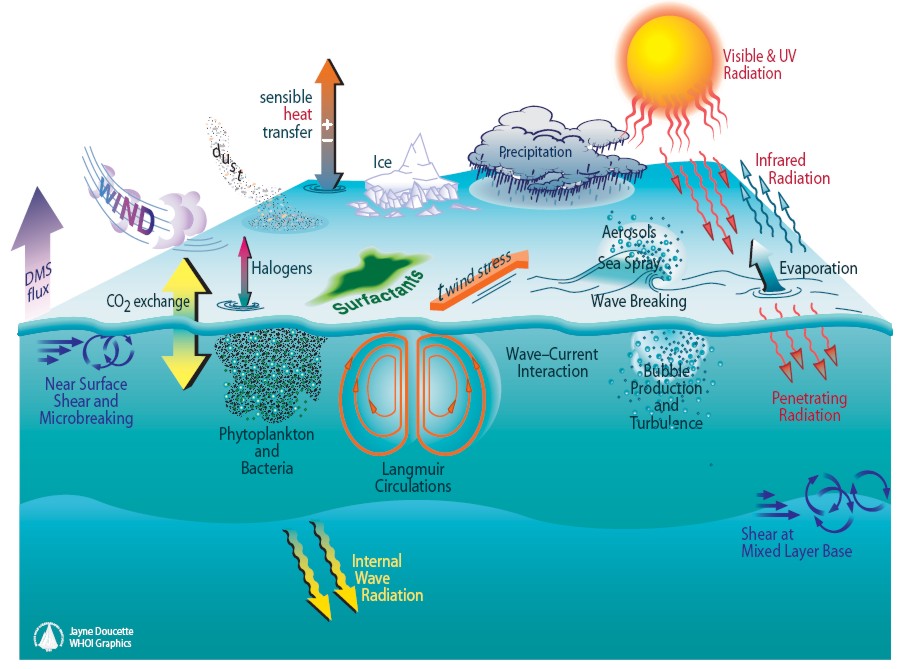







Surface Mixed Layer Depth (MLD)

Schematic of processes operating at the air-sea interface and in the upper ocean mixed layer. (Illustration from Jayne Doucette, Woods Hole Oceanographic Institution)
The term "mixed" refers to a given physical parameter of the ocean state (e.g. temperature, density...) that is assumed to be mixed and homogeneous to a certain level (e.g. regarding some space/time scales), from the surface down to the considered MLD. Here we want to estimate mixed layer over at least a daily cycle, and no more than a few days. This represents the depth over which surface fluxes have been recently mixed and integrated and is a caracteristic timescale of air-sea interactions.
The surface MLDs are estimated here directly on individual profiles with data at observed levels. MLD is defined through the threshold method with a finite difference criterion from a near-surface reference value. A linear interpolation between levels is then used to estimate the exact depth at wich the difference criterion is reached. The reference depth is set at 10 m to avoid a large part of the strong diurnal cycle in the top few meters of the ocean. The chosen temperature criterion is 0.2°C absolute difference from surface (DT). The fixed criterion in density is 0.03 kg/m3 difference from surface (DR with R for Rho i.e. density). The variable criterion in density corresponds to a 0.2°C variation in local temperature/salinity conditions, it is obviously linked to the temperature criterion and enables the definition of the BLT. (See de Boyer Montégut et al. JGR 2004, [1] for further details about the choice of the criterion).
NB: such a definition of the MLD with a reference depth at 10 m for the threshold criterion, gives mld fields necessarily deeper than 10 m. The basic hypothesis being that the surface layer is always mixed on at least 10 m depth within one or two days. Be carefull that in region with strong upwelling (e.g. in eastern equatorial Pacific ocean) a minimum of 10 m might already be to deep as there does not exist a vertical uniformely mixed layer at the surface due to permanent upwelling.
1. MLD in temperature with a fixed threshold criterion (0.2°C)
This mixed layer depth is a Temperature-Mixed Layer
Depth, or Isothermal Layer Depth. It is
reminded that T°C inversions are NOT contained into
this isothermal layer!
We estimate this MLD, named MLD_DT02, from a fixed threshold on temperature
profiles. The criterion is the following :
MLD_DT02 = depth where (θ = θ10m ± 0.2 °C)
We give hereunder the datasets that we have
constructed so far for this MLD_DT02 temperature-mixed layer
depth.
| 1.1. Global Scale, Annual Climatology (12 month) |
| Space/Time Resolution | Basic T/S Profiles Used | Data File | Plots | Reference(s) |
|---|---|---|---|---|
|
≃ 5 million temperature profiles More info...
|
mld_DT02_c1m_reg2.0_Global.nc [4.7 Mo] (updated Nov. 2008) |
|
de Boyer Montégut et al., 2004 [1] |
| 1.2. Mediterranean Sea, Annual climatology (12 month) |
| Space/Time Resolution | Basic T/S Profiles Used | Data File | Plots | Reference(s) |
|---|---|---|---|---|
|
≃ 240,000 temperature profiles More info...
|
Data files available on request to Fabrizio d'Ortenzio (updated 2005) |
|
d'Ortenzio et al., 2005 [3] |
| 1.3. Indian Ocean, Interannual climatology (41 years) |
| Space/Time Resolution | Basic T/S Profiles Used | Data File | Plots | Reference(s) |
|---|---|---|---|---|
|
≃ 565,000 temperature profiles More info...
|
mld_DT02_i1m_reg2.0_IndianOcean.nc [33 Mo] (updated Mar. 2011) |
|
Keerthi et al., 2012 [2] |
2. MLD in density with a fixed threshold criterion (0.03kg/m3)
This mixed layer depth is a Density-Mixed Layer
Depth, or Isopycnal Layer Depth.
We estimate this MLD, named MLD_DR003, from a fixed threshold on density
profiles. The criterion is the following :
MLD_DR003 = depth where(σ0 = σ010m+ 0.03 kg.m-3)
DATA| 2.1. Global Scale, Annual Climatology (12 month) |
| Space/Time Resolution | Basic T/S Profiles Used | Data File | Plots | Reference(s) |
|---|---|---|---|---|
|
≃ 880,000 density profiles More info...
|
mld_DR003_c1m_reg2.0_Global.nc [4.7 Mo] (updated Nov. 2008) |
|
de Boyer Montégut et al., 2004 [1] |
|
≃ 4.5 million density profiles |
mld_dR003_ref10 from SEANOE (updated Nov. 2022) |
see on SEANOE |
SEANOE de Boyer Montégut et al., 2004 [1] |
3. MLD in density with a variable threshold criterion (equivalent to a 0.2°C decrease)
This mixed layer depth is a Density-Mixed Layer
Depth, or Isopycnal Layer Depth.
We estimate this MLD, named MLD_DReqDTm02, from
a variable threshold on density profiles. The
variable criterion in density corresponds to a 0.2°C
variation in local temperature/salinity conditions. The
definition of this depth is obviously linked to MLD_DT02
presented above. Their comparison enables to estimate
salinity effects on stratification and gives a way to
compute Barrier Layer Thickness
(BLT).
The criterion is the following :
|
MLD_DReqDTm02 = depth where ( σ0 =
σ010m +
Δσ0 ) with Δσ0 = σ0(θ10m - 0.2°C, S10m, P0) - σ0(θ10m, S10m, P0) |
In other words, it is the depth where the density INCREASE
compared to density at 10 m depth corresponds to a
temperature decrease of 0.2°C in local surface
conditions (θ10m, S10m,
P0= 0 db, surface pressure). For example:
-
with S10m = 35 psu, θ10m = 25
°C : Δσ0 = 0.060 kg/m3
- with
S10m = 35 psu, θ10m = 15 °C
: Δσ0 = 0.044 kg/m3
- with
S10m = 35 psu, θ10m = 5 °C :
Δσ0 = 0.023 kg/m3
NB: the fixed
threshold criterion in density with 0.03 kg/m3 (cf previous
section) corresponds to a 0.2 °C variation in
temperature only in conditions close to: S10m = 35
psu, θ10m = 8 °C
(Δσ0 = 0.03 kg/m3)
| 3.1. Global Scale, Annual Climatology (12 month) |
| Space/Time Resolution | Basic T/S Profiles Used | Data File | Plots | Reference(s) |
|---|---|---|---|---|
|
≃ 780,000 density profiles More info...
|
mld_DReqDTm02_c1m_reg2.0_Global.nc [4.7 Mo] (updated Nov. 2008) |
|
de Boyer Montégut et al. 2004 [1] de Boyer Montégut et al. 2007 [4] Mignot et al. 2007 [5] |